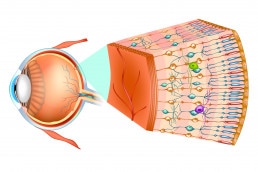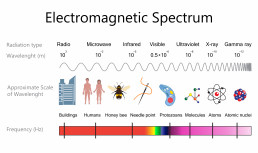The eye is our most important and most sensitive organ, in both sensory and physical terms. Light with a high energy density can cause irreversible damage to the light-sensitive photoreceptors. In this blog article, we take a look at the effects on the eye caused by LED lighting and illustrate the impact of LEDs on the retina.
The visual process
The human eye works like a camera: the refractive apparatus produces an image on the retina, which can be adapted to various visual situations. The lens uses accommodation to provide us with sharp close-range and long-range vision. The pupil acts like a variable pinhole aperture and helps to produce the image by adjusting the amount of light that enters the eye.
Light is visible to the human eye from wavelengths of 400 nm and over. Visual function is based on the exceedingly high specialisation of the tissues involved, which pushes the limits of cellular metabolism. The photoreceptors, which produce electrical impulses from the image and begin the visual process, are extremely physically sensitive – one light quantum (also known as a photon) is enough to trigger a physiological reaction. In return for this, however, they are highly sensitive to damage caused by high-energy light. This means that high-intensity visible light damages the photoreceptors, which is why you should always remember to never look directly at the sun without eye protection.
The image is converted into electrical impulses by the light-sensitive retina and broken down into its component information by the retina’s neural network, which is then transmitted by the optic nerve to the brain – this is where the visual process takes place.

Natural harmful effects of light on the eye: UV light
The shorter the wavelength, the higher-energy the light, and therefore the greater the damage that can be expected. UV light is therefore very dangerous.
UV light leads to eye damage, and the outer tissues of the eye are particularly exposed to the UV component of light. The outer tissues are the conjunctiva and the eyelid. Direct or indirect damage to genetic material can occur in these tissues, which may lead to tumour formation. Although the efficient repair mechanism largely helps to prevent tumours forming, too much DNA damage can impede this repair mechanism and give rise to tumour formation. UVB radiation acutely damages the cells and can cause necrotic damage, cell death and inflammatory reactions – known as sunburn on the rest of the skin on the body.
Artificial UV light from the light radiation produced during welding can also cause damage to the conjunctiva, which creates a gritty sensation in the eye – photokeratitis, also known as arc eye or snow blindness. In less severe cases, symptoms will last one or two days and include tears, an intense feeling that something is in the eye, sensitivity to light and eyelid spasms. In the worst case scenario, corneal cells may become detached or necrosed.
In the same way, light also causes cellular damage to the tissues that are directly involved in the visual process. The cornea and lens absorb almost the entire part of the light spectrum with the highest energy: UV light, with wavelengths of less than 390 nm. This can lead to oxidative stress and damage to DNA in the cells that help to keep the eyes clear and protect the tissue. In the cornea, a substantial part of this high-energy light is absorbed by the outermost layer of the eye. Here, DNA repair mechanisms continually compensate for the damage caused to the cornea by UV rays. When these repair mechanisms are unable to keep up with the rate of damage, this leads to corneal damage and cataracts. Artificially produced UV light, such as the light produced by UV-emitting light fittings, sunbeds and welding using electric welding equipment, can also contribute to this.
Wavelength spectra at a glance:
- 100 nm to 800 nm: electromagnetic waves in light
- < 100 nm: X-rays
- > 800 nm: thermal radiation
- 100 nm to 400 nm: ultraviolet light

Effect on the retina – LED light eye damage
Since UV light is almost fully absorbed by the cornea and lens (see H3), the highest-energy light that reaches the retina is blue light (410-470 nm). This can cause acute damage to the retina if the light is strong enough, such as when a person looks directly at the sun – in this case, just a brief period of exposure is enough to cause damage. There have also been cases of retinal damage caused by longer periods of exposure to very bright artificial light sources.
This is why you must always ensure you use adequate eye protection when in regular contact with LED light – you will be sure to find the right protection for you in our range of uvex safety spectacles:
I would have given it 5* but the 5th* was below; clicked too soon; should all be in 1 line.
Excellent, informative & valuable information. As valuable as your sight!
Thank you.????